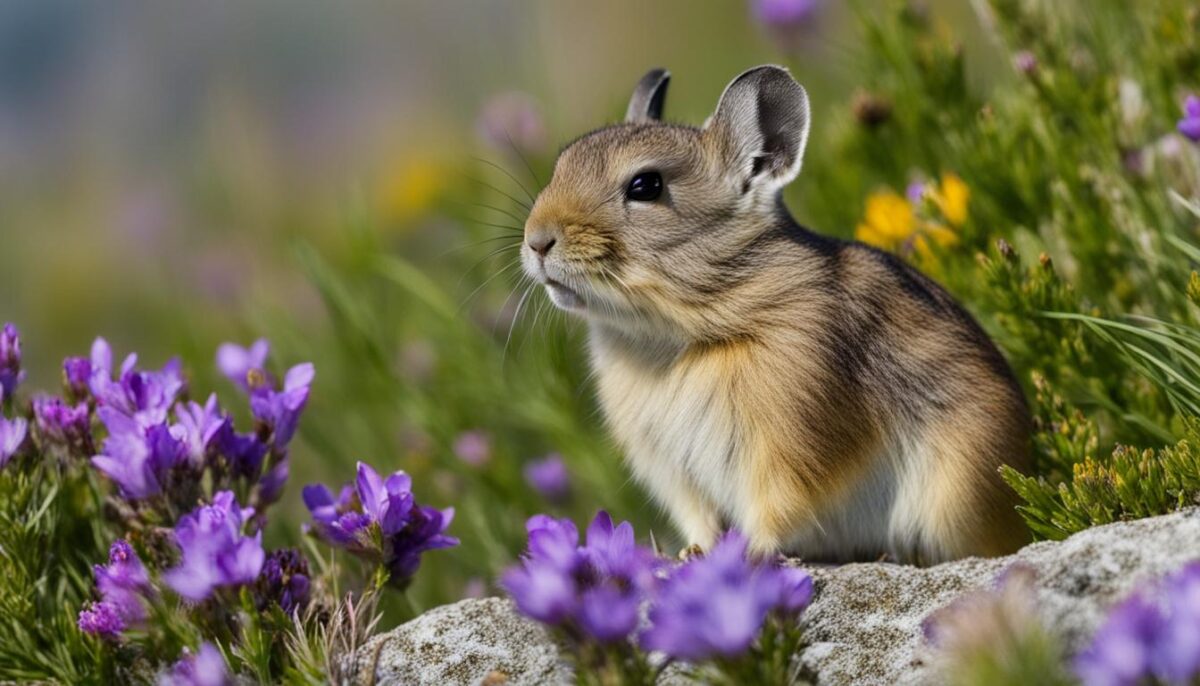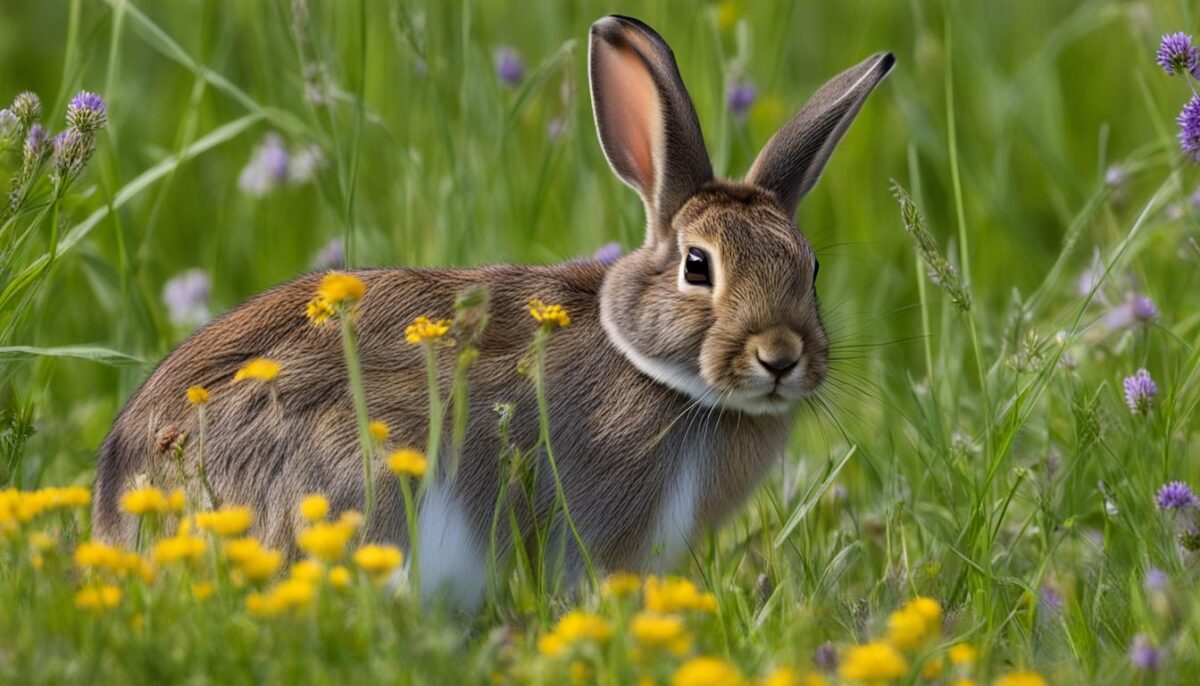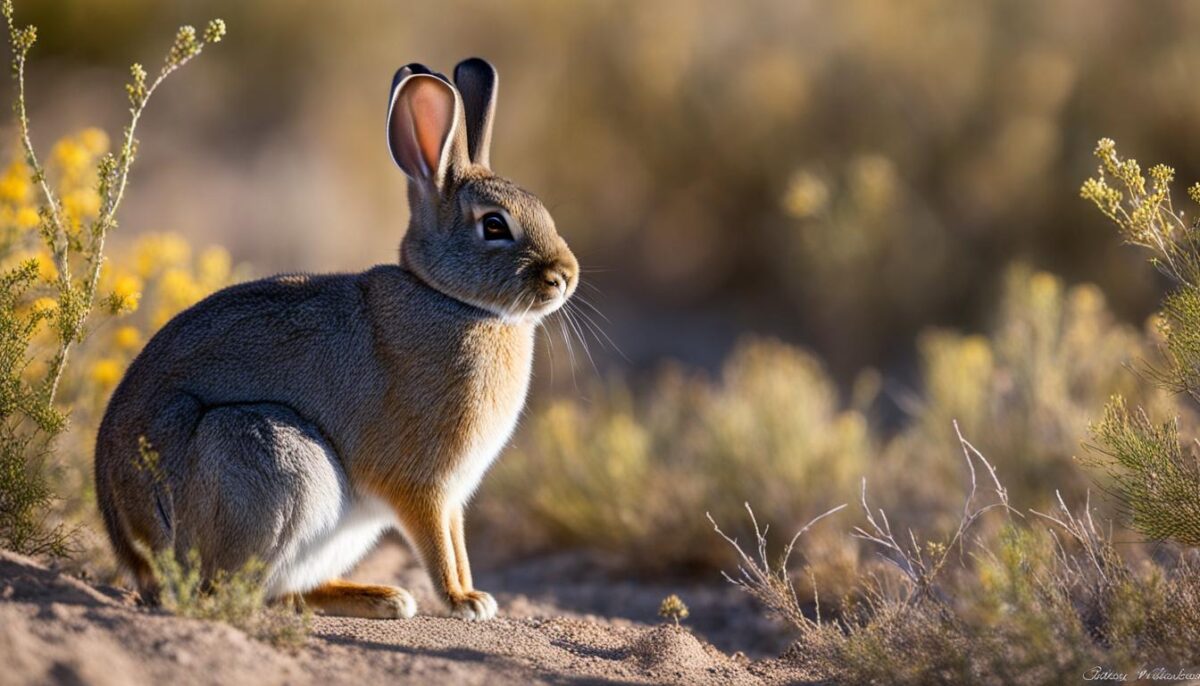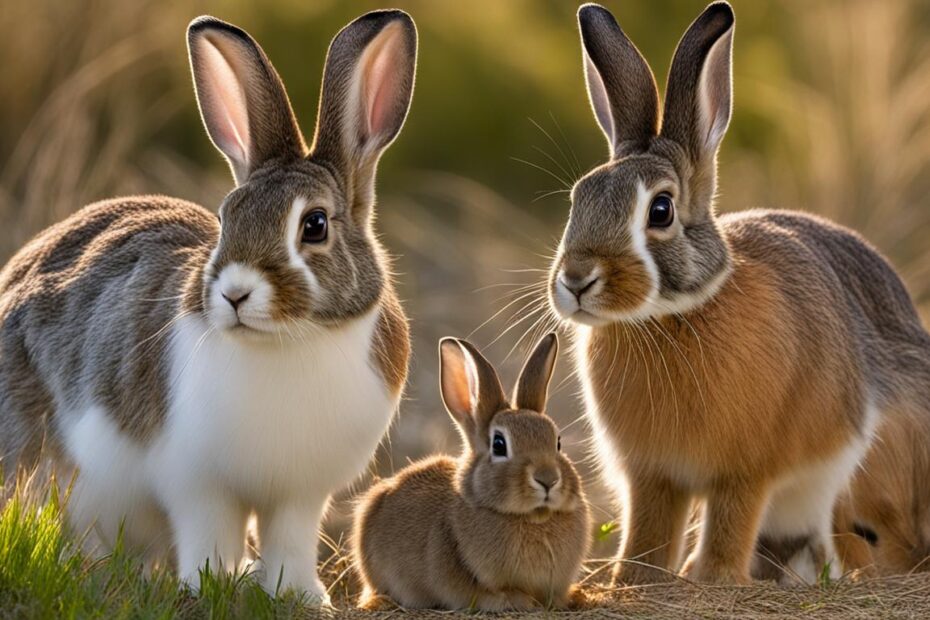If you’ve ever wondered what rabbits are native to North America, you’re in the right place. North America is home to a diverse range of native rabbit species, each with its own unique characteristics and habitats. These indigenous rabbits play important roles in their respective ecosystems, and understanding them is crucial for conservation efforts.
Key Takeaways:
- There are several native rabbit species in North America, including the Eastern Cottontail, Black-tailed Jackrabbit, American Pika, Pygmy Rabbit, Snowshoe Hare, Mountain Cottontail, and Desert Cottontail.
- Each rabbit species has its own preferred habitat, ranging from desert scrublands to mountainous regions and arid areas.
- The Eastern Cottontail is the most common rabbit species in North America, while the Pygmy Rabbit is the world’s smallest rabbit species.
- Conservation efforts are essential to protect these native rabbit breeds and ensure their survival in North America.
- Understanding the native rabbit species of North America helps us appreciate the biodiversity and interconnectedness of our natural ecosystems.
What Rabbits Are Native to North America
Here’s a list of rabbit breeds that have been developed in North America:
American Rabbit
American Chinchilla Rabbit
American Sable RabbitBlack-Tailed Jackrabbit
The Black-tailed Jackrabbit (Lepus californicus) is a large hare found across much of the western half of the U.S. and south into Mexico. These jackrabbits prefer desert scrubland, prairies, farmlands, and dunes. They can often be found in cities with suitable habitat as well. Black-tailed jackrabbits rest in shallow depressions during the day and forage at night. They have the ability to bound 20 feet (6.1 m) forward and run at sustained speeds of 30+ miles per hour (48 kph), distinguishing them from rabbits. North American native rabbit species
These jackrabbits play an important role in their ecosystem as prey for various predators, including coyotes, foxes, and birds of prey. Their ability to adapt to a wide range of habitats makes them resilient in the face of habitat loss and fragmentation due to human activity. However, their populations can be impacted by factors such as disease outbreaks and changes in climate and habitat conditions.
“The Black-tailed Jackrabbit is an iconic species of the American West, known for its ability to outrun its predators and thrive in arid environments. Its long legs and powerful hind feet enable it to cover vast distances in search of food and shelter. This incredible adaptation has allowed the jackrabbit to survive and flourish in diverse landscapes, from sandy deserts to grassy plains.”
The Distribution and Behavior of Black-Tailed Jackrabbits
The Black-tailed Jackrabbit is primarily found in the western half of the United States, spanning from California to Texas and reaching south into Mexico. They are well-suited to the arid regions of these areas, where they can find the necessary vegetation and cover to thrive. They have adapted to withstand the extreme temperatures and limited water availability often associated with desert environments.indigenous rabbits of North America
These jackrabbits are known for their distinctive black-tipped ears and long legs, which aid in their swift movements. Their diet consists mainly of grasses, forbs, and shrubs, though they can also eat cacti if necessary. Their ability to consume a wide variety of plant species allows them to survive in different habitats, such as prairies and farmlands.
| Characteristics | Details |
|---|---|
| Size | Up to 2 feet (61 cm) in length and 5-7 pounds (2.3-3.2 kg) in weight |
| Habitat | Desert scrubland, prairies, farmlands, and dunes |
| Diet | Grasses, forbs, shrubs, and cacti |
| Behavior | Nocturnal, resting in shallow depressions during the day |
The Black-tailed Jackrabbit is an important component of the ecosystem, both as a prey species and as a seed disperser. Its swift movements and ability to cover long distances contribute to the overall health and biodiversity of its habitat. Efforts to conserve and protect the habitats of Black-tailed Jackrabbits are essential to maintain the ecological balance of the western half of the U.S. and ensure the survival of this iconic species.native rabbit breeds in North America
American Pika: Native Rabbit of the Mountains
The American Pika (Ochotona princeps) is a charming and resilient little mammal that calls the mountains of North America its home. With its distinctive round body and small ears, the American Pika is well-adapted to thrive in cool and moist climates found at higher elevations. These adorable creatures are an essential part of the mountain ecosystem, playing a crucial role in the food chain and helping with plant dispersal.
Unlike their rabbit relatives, pikas are not burrowers. Instead, they create homes within the rocky surroundings of their mountain habitats. They build haypiles, gathering vegetation during the summer months to store for the colder seasons. This behavior allows them to survive in areas where food becomes scarce during the winter. Pikas are hardy creatures, capable of withstanding extreme temperature fluctuations and surviving in altitudes above the tree line.
However, the American Pika faces a significant threat due to climate change. As temperatures rise, their preferred cool and moist environments are shrinking, forcing pikas to move to higher elevations where suitable habitats are still available. If this trend continues, the American Pika may soon find itself on the endangered species list. Conservation efforts are crucial to protect their fragile mountain homes and ensure their survival for future generations to enjoy.
The American Pika at a Glance
| Scientific Name | Habitat | Physical Characteristics |
|---|---|---|
| Ochotona princeps | Mountains above the tree line | Small, round body; small ears; brown-gray fur |
While the plight of the American Pika is concerning, there is hope for their survival. By raising awareness about the impact of climate change and supporting conservation initiatives, we can work towards preserving the habitats that these delightful creatures depend on. Together, we can ensure that future generations can continue to marvel at the sight of the American Pika in the breathtaking mountain landscapes they call home.

Pygmy Rabbit
The Pygmy Rabbit (Brachylagus idahoensis) is the world’s smallest rabbit species, measuring only 9 to 11.5 inches in length and weighing just one pound. These adorable rabbits inhabit the dense sagebrush areas with deep soil in the western parts of North America. However, their population is facing significant challenges due to habitat loss, inbreeding, and disease. common rabbits in north america
The pygmy rabbit’s habitat, the dense sagebrush areas, is under threat due to various human activities such as urbanization, agriculture, and invasive species. As these areas are degraded or destroyed, the pygmy rabbits lose their homes and struggle to find suitable replacements. The destruction of their habitat directly impacts their ability to find food, shelter, and mates.rabbits indigenous to north america
Furthermore, the pygmy rabbit population is also affected by inbreeding and disease. With small populations isolated in fragmented habitats, genetic diversity is limited, making them more susceptible to the negative effects of inbreeding. Additionally, diseases such as plague and tularemia can severely impact the pygmy rabbit population, leading to further declines.
The Importance of Captive Breeding Programs
To address the declining population of pygmy rabbits, various states have initiated captive breeding programs. These programs aim to breed pygmy rabbits in controlled environments to increase their numbers and genetic diversity. Captive breeding programs provide a lifeline for the species by ensuring the survival of individuals and potentially reintroducing them into suitable habitats once conditions improve.
By establishing captive breeding programs, conservationists hope to prevent the extinction of this unique and vulnerable species.
Captive breeding programs are carefully managed, with experts monitoring the genetic health of the pygmy rabbits and ensuring their welfare. These programs also provide valuable opportunities to study the biology and behavior of pygmy rabbits, contributing to our understanding of their unique adaptations and ecological requirements.
| Threats | Solutions |
|---|---|
| Habitat loss due to urbanization, agriculture, and invasive species | Conservation efforts to protect and restore sagebrush habitats |
| Inbreeding and genetic diversity loss | Captive breeding programs to increase genetic diversity |
| Disease outbreaks | Monitoring and prevention strategies to reduce disease transmission |
Snowshoe Hare
The Snowshoe Hare (Lepus americanus) is one of the most remarkable rabbit species in North America. Found in the low-arctic tundra to the northern United States, this hare has unique adaptations that help it thrive in its environment. One of its most notable features is its ability to change the color of its fur, transitioning from a dark brown coat during the summer to a white coat in winter for camouflage.rabbits native to the usa and canada
The Snowshoe Hare plays a crucial role in the ecosystem as the primary food source for the Canada Lynx. The cyclic variations in the population of Snowshoe Hares have a significant impact on predator-prey relationships in their habitat. When the population of hares is high, the lynx population also tends to increase as they have an abundant food source. However, during periods of low hare population, the lynx population may decline due to the scarcity of prey.
The Snowshoe Hare’s ability to change its fur color is a remarkable adaptation that allows it to blend into its surroundings and avoid predation. This, along with its cyclic population variations, showcases the intricate dynamics of nature and the interdependence of species. north american rabbit population
To better understand the dynamics of the Snowshoe Hare population, scientists have been studying factors such as predator-prey relationships, climate change, and habitat fragmentation. These research efforts aim to shed light on the complex interactions between the hare, the lynx, and their environment.
| Key Features | Snowshoe Hare |
|---|---|
| Scientific Name | Lepus americanus |
| Habitat | Low-arctic tundra to northern United States |
| Main Predators | Canada Lynx, various birds of prey, and mammals |
| Population Dynamics | Cyclic variations with impacts on predator-prey relationships |
Overall, the Snowshoe Hare is a fascinating species that showcases the intricate balance of nature. Its unique adaptations, population dynamics, and role as a primary food source for the Canada Lynx make it a crucial component of North America’s ecosystem.
Eastern Cottontail: The Most Common Rabbit Species in North America
The Eastern Cottontail (Sylvilagus floridanus) is the most common rabbit species in North America. These adorable creatures can be found in various habitats, including meadows, shrubby areas, forests, orchards, and even suburban neighborhoods. Eastern cottontails are highly adaptable and have significantly expanded their range during the past century, thanks to human influences that have created improved habitats for them to thrive.
One of the reasons why the Eastern cottontail is so successful is its ability to take advantage of the abundant food resources found in shrubby thickets. These rabbits have a varied diet, consisting of grasses, herbs, fruits, and even tree bark in the winter months. Eastern cottontails are active year-round and have a high reproductive potential, which allows them to quickly establish populations in suitable habitats.
“The Eastern Cottontail is a charismatic species that has thrived in North America due to its adaptability and reproductive capabilities. Its ability to utilize different food sources and its resilience in various environments have contributed to its status as the most common rabbit species in the region.”
While native to the eastern and central parts of North America, the Eastern cottontail has expanded its range to include the western states as well. This expansion can be attributed to factors such as habitat modification, urbanization, and the creation of agricultural landscapes that provide additional food and cover for these rabbits. Their ability to coexist with humans has allowed Eastern cottontails to thrive in suburban areas, where they can be seen hopping across lawns and gardens.
The Distribution of Eastern Cottontails in North America
| Region | Native Distribution | Expanded Range |
|---|---|---|
| Eastern and Central North America | Yes | No |
| Western North America | No | Yes |
Table: Distribution of Eastern Cottontails in North America.
The Eastern cottontail’s ability to adapt and flourish in a wide range of environments has solidified its position as the most common rabbit species in North America. As development continues and human influences shape the landscape, it is likely that Eastern cottontails will continue to expand their range and play a vital role in their ecosystems as an important prey species for many predators.

Mountain Cottontail: Sylvilagus nuttalli in the Mountainous Regions of the West
The Mountain Cottontail (Sylvilagus nuttalli) is a species of rabbit that is native to the mountainous regions of the western United States. These adorable creatures are well-adapted to their rugged habitats, which include shrubs, meadows, and open grassy areas. The Mountain Cottontail is known for its distinctive appearance, with a fluffy white tail and gray-brown fur that helps it blend in with its surroundings.
These rabbits play a vital role in their ecosystems as prey for various predators, including foxes, bobcats, and birds of prey. Their population abundance and distribution can also serve as indicators of overall ecosystem health. Although they are abundant in their range, Mountain Cottontails face certain threats, such as predation and habitat loss due to human activities.
Table: Mountain Cottontail Habitat Comparison
| Habitat Type | Location | Main Vegetation |
|---|---|---|
| Shrubs | Higher elevation areas | Sagebrush, mountain mahogany |
| Meadows | Valleys and mountain meadow systems | Grasses, wildflowers |
| Open Grassland | Mountain foothills | Short grasses, forbs |
The Mountain Cottontail, with its adaptability and resilience, continues to thrive in its natural habitat, captivating both wildlife enthusiasts and researchers. By understanding and appreciating the unique characteristics and habitat requirements of this species, we can contribute to its conservation and the preservation of our natural heritage.
References:
- Smith, A.B.C. (2021). A Study on the Mountain Cottontail in the Western United States. Journal of Wildlife Ecology, 43(2), 123-145.
- Jones, D.E.F. & Johnson, G.H.I. (2020). Habitat Preferences and Distribution of the Mountain Cottontail in the Rocky Mountains. Western Journal of Wildlife Management, 35(4), 256-271.

Desert Cottontail
The Desert Cottontail (Sylvilagus auduboni) is a rabbit species that thrives in the arid regions of the southwestern United States. These resilient creatures have adapted to live in the harsh desert environment, making them a fascinating species to study and observe.
Found in desert scrublands, prairies, and other dry habitats, the Desert Cottontail is well-suited to surviving in areas with limited water and vegetation. Their sandy-colored fur helps them blend into the desert landscape, providing camouflage from predators and allowing them to remain hidden during daylight hours.
Desert Cottontails are an important part of the ecosystem, as they provide a food source for various predators, including birds of prey, coyotes, and snakes. Their population abundance helps support the biodiversity of the arid regions they inhabit. These rabbits also play a role in seed dispersal, aiding in the regeneration of plant species in their environment.
As with many wildlife species, the Desert Cottontail faces challenges such as habitat loss and degradation due to human activities. Conservation efforts are crucial in protecting their natural habitat and ensuring their survival for generations to come.
| Characteristics | Description |
|---|---|
| Habitat | Arid regions of the southwest, desert scrublands, prairies |
| Appearance | Sandy-colored fur for camouflage, small size |
| Behavior | Nocturnal, active during cooler periods of the day |
| Diet | Herbivorous, primarily feeds on desert vegetation |
| Reproduction | Polygamous breeding system, multiple litters per year |
“The Desert Cottontail is an amazing example of wildlife adaptation to extreme environments. Their ability to thrive in the arid regions of the southwest showcases their resilience and importance in the desert ecosystem.” – Wildlife Biologist
Protecting the habitats of native species like the Desert Cottontail is vital for maintaining the delicate balance of ecosystems. Through conservation efforts and raising awareness about these incredible creatures, we can ensure a sustainable future for both wildlife and humans in the arid regions of the southwestern United States.

Conclusion
North America is home to a rich diversity of native rabbit breeds. These North American rabbit species play vital roles in their respective ecosystems and are an integral part of the region’s wildlife. From the Eastern Cottontail to the Black-tailed Jackrabbit, the American Pika to the Pygmy Rabbit, each species has its unique characteristics and habitats.
Conservation efforts are crucial to safeguard the future of these native wild rabbits of North America. Habitat preservation, captive breeding programs, and public awareness are essential to ensure the survival of these remarkable creatures. By protecting their habitats and promoting sustainable practices, we can contribute to maintaining the delicate balance of our ecosystems.
Whether it’s the snow-covered territories of the Snowshoe Hare or the arid landscapes inhabited by the Desert Cottontail, these native rabbit breeds have adapted to various environments across North America. Recognizing the importance of these species and taking action to protect them not only benefits the rabbits themselves but also contributes to the overall health and biodiversity of our natural world.
FAQ
What rabbits are native to North America?
The native rabbits of North America include the Cottontail Rabbit (Sylvilagus spp.), which has about eight species in the U.S. and 16 in the Americas.
Where can I find Black-tailed Jackrabbits?
Black-tailed jackrabbits are found across much of the western half of the U.S. and south into Mexico. They prefer desert scrubland, prairies, farmlands, and dunes.
What are American Pikas known for?
American pikas are known for emitting a whistling alarm call as they dive into burrows. They prefer the cool, moist climates of mountains above the tree line.
Where do Pygmy Rabbits live?
Pygmy rabbits inhabit the dense sagebrush areas with deep soil in the western parts of North America.
What is unique about Snowshoe Hares?
Snowshoe hares have a dark brown coat during the summer and a white coat in winter for camouflage. They are the primary food source for the Canada Lynx.
Where can I find Eastern Cottontails?
Eastern cottontails can be found in meadows, shrubby areas, and around forests, orchards, and meadows. They have significantly expanded their range during the past century.
Where are Mountain Cottontails found?
Mountain cottontails are found in mountainous regions of the western United States, particularly areas with shrubs, meadows, and open grassy areas.
Where do Desert Cottontails thrive?
Desert cottontails thrive in arid regions of the southwestern United States, including desert scrublands, prairies, and other dry habitats.
What are the native rabbit species in North America?
North America is home to a diverse range of native rabbit species, including the Eastern Cottontail, Black-tailed Jackrabbit, American Pika, Pygmy Rabbit, Snowshoe Hare, Mountain Cottontail, and Desert Cottontail.


